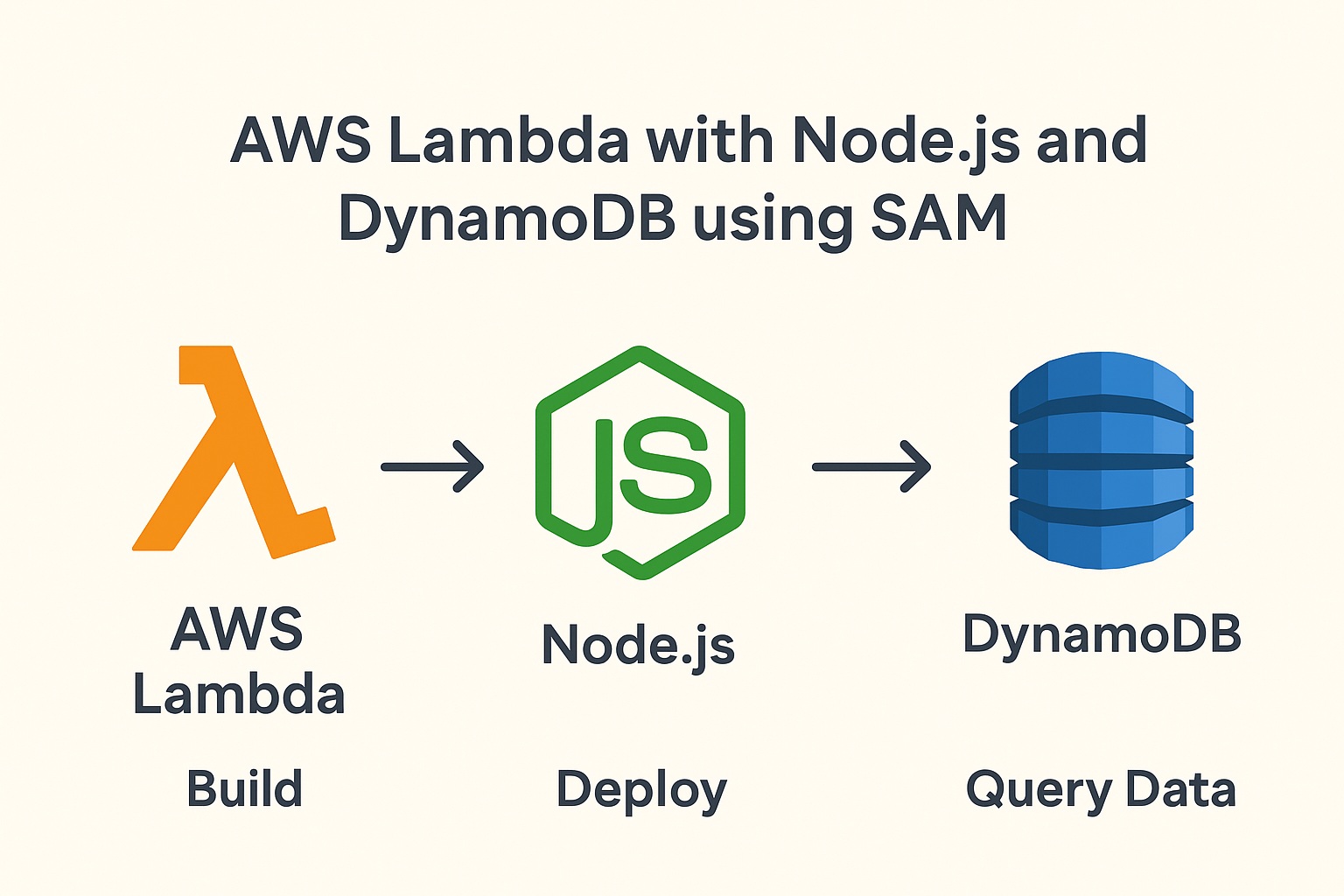In this tutorial, you’ll learn how to create a simple AWS Lambda function in Node.js, query data from a DynamoDB table, define the Lambda in a SAM template.yaml and deploy the Lambda with AWS SAM CLI.
1. Prerequisites
Before starting, make sure you have:
- An AWS account
- AWS CLI installed and configured (
aws configure) - AWS SAM CLI installed (docs)
- Node.js (v16 or higher recommended)
2. Project Setup
Create a new project folder:
mkdir sam-dynamodb-lambda
cd sam-dynamodb-lambda
sam init
Choose:
- Runtime:
nodejs18.x - Package type:
Zip - Template:
Hello World Example
This will scaffold a project.
3. DynamoDB Table Setup
For our example, let’s create a table called BooksTable with id as the primary key:
aws dynamodb create-table \
--table-name BooksTable \
--attribute-definitions AttributeName=id,AttributeType=S \
--key-schema AttributeName=id,KeyType=HASH \
--provisioned-throughput ReadCapacityUnits=5,WriteCapacityUnits=5
Insert some sample data:
aws dynamodb put-item \
--table-name BooksTable \
--item '{"id": {"S": "1"}, "title": {"S": "AWS Lambda in Action"}, "author": {"S": "John Developer"}}'
aws dynamodb put-item \
--table-name BooksTable \
--item '{"id": {"S": "2"}, "title": {"S": "Serverless Made Simple"}, "author": {"S": "Jane Doe"}}'
4. Lambda Function Code
Navigate into the function folder hello-world (generated by SAM) and update app.js:
// app.js
const AWS = require("aws-sdk");
const dynamodb = new AWS.DynamoDB.DocumentClient();
const TABLE_NAME = process.env.TABLE_NAME;
exports.lambdaHandler = async (event) => {
try {
// If an id is provided in query params, fetch a single book
if (event.queryStringParameters && event.queryStringParameters.id) {
const id = event.queryStringParameters.id;
const result = await dynamodb
.get({
TableName: TABLE_NAME,
Key: { id },
})
.promise();
return {
statusCode: 200,
body: JSON.stringify(result.Item || {}),
};
}
// Otherwise, scan all items
const result = await dynamodb.scan({ TableName: TABLE_NAME }).promise();
return {
statusCode: 200,
body: JSON.stringify(result.Items),
};
} catch (err) {
return {
statusCode: 500,
body: JSON.stringify({ error: err.message }),
};
}
};5. SAM Template
Update your template.yaml to include DynamoDB table and environment variable:
AWSTemplateFormatVersion: '2010-09-09'
Transform: AWS::Serverless-2016-10-31
Description: >-
SAM Template for Lambda + DynamoDB example
Globals:
Function:
Timeout: 5
Runtime: nodejs18.x
Resources:
BooksTable:
Type: AWS::DynamoDB::Table
Properties:
TableName: BooksTable
AttributeDefinitions:
- AttributeName: id
AttributeType: S
KeySchema:
- AttributeName: id
KeyType: HASH
ProvisionedThroughput:
ReadCapacityUnits: 5
WriteCapacityUnits: 5
GetBooksFunction:
Type: AWS::Serverless::Function
Properties:
CodeUri: hello-world/
Handler: app.lambdaHandler
Environment:
Variables:
TABLE_NAME: !Ref BooksTable
Policies:
- DynamoDBReadPolicy:
TableName: !Ref BooksTable
Events:
ApiEvent:
Type: Api
Properties:
Path: /books
Method: get
6. Build and Deploy
Run:
sam build
sam deploy --guided
Follow the prompts:
- Stack name:
books-lambda-stack - AWS region:
us-east-1(or your region) - Accept defaults
After deployment, SAM will output an API Gateway URL.
7. Test the Lambda
Get all books:
curl https://<your-api-gateway-url>/books
Get a single book by id:
curl "https://<your-api-gateway-url>/books?id=1"
Conclusion
You’ve just created a fully working AWS Lambda function in Node.js that:
- Reads from a DynamoDB table
- Is defined and deployed via AWS SAM
- Is accessible through API Gateway
This approach is scalable, repeatable, and production-ready.



